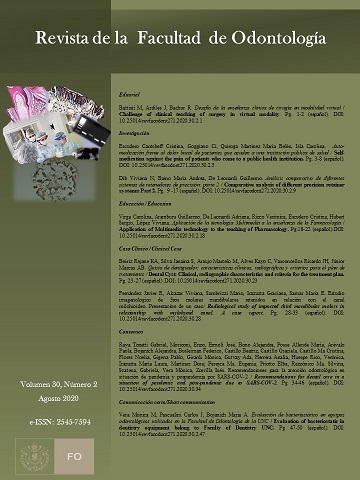Microbiological evaluation of dental equipment flexible tube treated with a bacteriostatic
Keywords:
descontaminación, unidades odontológicas, AlphaSanAbstract
In health and in the area of Dentistry, it is important to know the risk of infection for the patient and contaminated dental instruments and equipment can transmit health personnel, since many of the infections. From the point of view of infection control, the essential elements in this subject are not fully developed; an example is the cleaning and decontamination of dental equipment and the quality of the water that reaches it. Microbial contamination of the hoses of dental units by the action of biofilms formed by microorganisms makes access and the action of different bacteriostats difficult. Currently, there are dental equipment in which the water conductive hoses treated with AlphaSan® (MillikenChemical). This is an inorganic product; it active substance is the silver ion, which has effects on bacterial cells, causing cell destruction
References
1. Rodrigues S, Suvarna S, Suvarna J, Saralaya V, Saldanha S, Shenoy VK. Microbial assessment of dental unit waterlines in an institutional setup in Karnataka, South India. Indian J Dent Res. 2017; 28(5):555-59.
2. Bueso T, Cálix Zúniga A, Altamirano E, Padilla J, Pineda L, Barahona L. Nivel de purificación del agua utilizada en clínicas odontológicas universitarias. Revista Científica de la Escuela Universitaria de las Ciencias de la Salud.2016,1(1).
3. Lizon J, Florentin A, Martrette Jm, Rivier A, Clement C, Rabaud C. Microbial control of dental unit water: Feedback on different disinfection methods experience. Am J Infect Control. 2016; 44(2):247-9.
4. Ouellet Mm, Leduc A, Nadeau C, Barbeau J, Charette SJ. Pseudomonas aeruginosa isolates from dental unit waterlines can be divided in two distinct groups, including one displaying phenotypes similar to isolates from cystic fibrosis patients. Frontier in Microbiol. 2015 Jan 21; 5:802.
5. Ezpeleta-Baquedanoa C, Barrios Andrésb JL, Delgado-Iribarren García-Campero A et al. Control microbiológico ambiental. Enferm Infecc Microbiol Clin. 2013; 31(6):396–401.
6. Sara Ávila De Navia1, Sandra Mónica Estupiñán Torres, Diana Milena Estupiñán Torres. Water quality of dental units. Scientific Publication in Biomedical Sciences. 2012; 10 (17).
7. Porteous NB, Luo J, Schoolfield J, Sun Y. The biofilm-controlling functions of rechargeable antimicrobial N-halamine dental unit waterline tubing. J Clin Dent 2011; 22(5):163–70
8. Kumar SL, Atray D, Paiwal D, Balasubramanyam G, Duraiswamy P, Kulkarni S. Dental unit waterlines: source of contamination and cross-infection. J Hosp Infect. 2010;74(2):99-111.
9. Nikaeen ML, Hatamzadeh M, Sabzevari Z, Zareh O. Microbial quality of water in dental unit waterlines. J Res Med Sci. 2009; 14(5):297-300.
10. Kampmann Y, De Clercke, S. Kohn S, D.K. Patchala Sk,Langerock R, Kreyenschmidt J. Study on the antimicrobial effect of silver-containing innerliners in refrigerators.The Society for Applied Microbiology, Journal of Applied Microbiology 2008; 104: 1808–14.
Published
Issue
Section
License

This work is licensed under a Creative Commons Attribution-NonCommercial-ShareAlike 4.0 International License.
Aquellos autores/as que tengan publicaciones con esta revista, aceptan los términos siguientes:
- Los autores/as conservarán sus derechos de autor y garantizarán a la revista el derecho de primera publicación de su obra, el cuál estará simultáneamente sujeto a la Licencia de reconocimiento de Creative Commons que permite a terceros:
- Compartir — copiar y redistribuir el material en cualquier medio o formato
- La licenciante no puede revocar estas libertades en tanto usted siga los términos de la licencia
- Los autores/as podrán adoptar otros acuerdos de licencia no exclusiva de distribución de la versión de la obra publicada (p. ej.: depositarla en un archivo telemático institucional o publicarla en un volumen monográfico) siempre que se indique la publicación inicial en esta revista.
- Se permite y recomienda a los autores/as difundir su obra a través de Internet (p. ej.: en archivos telemáticos institucionales o en su página web) después del su publicación en la revista, lo cual puede producir intercambios interesantes y aumentar las citas de la obra publicada. (Véase El efecto del acceso abierto).

